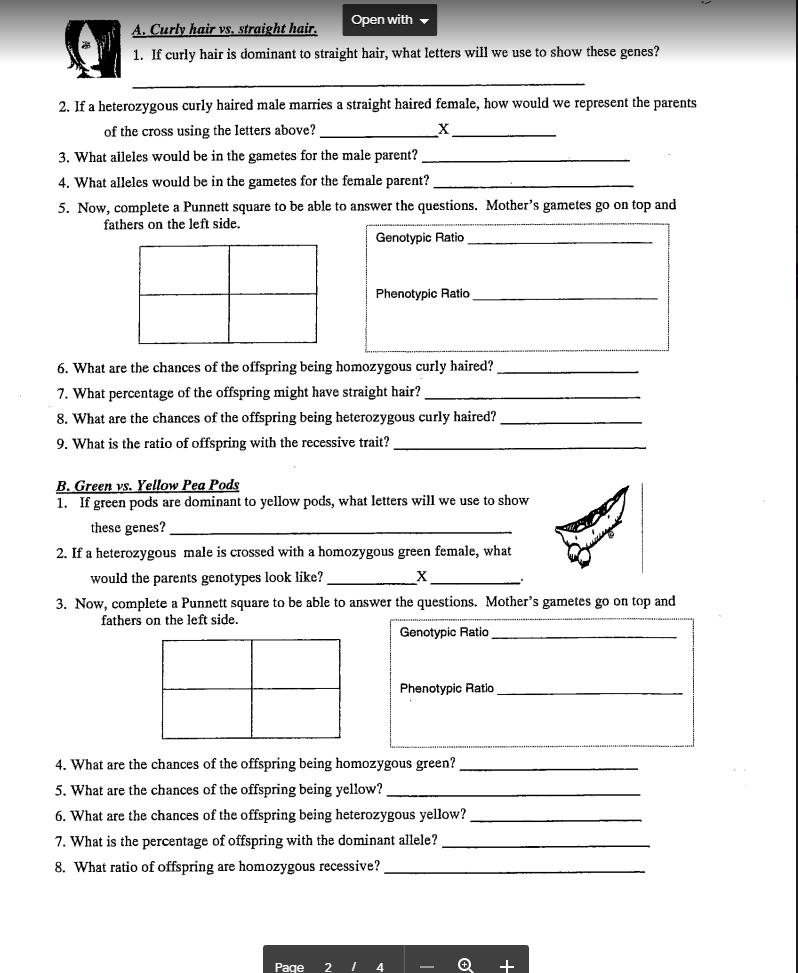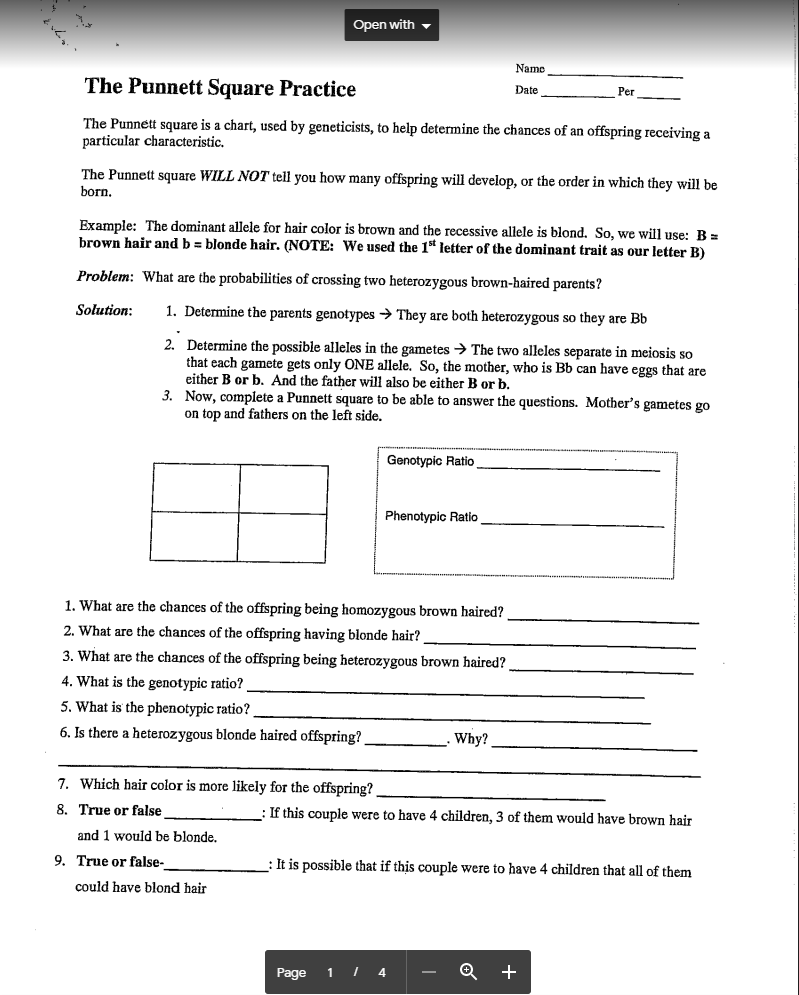1. If curly hair is dominant to straight hair, what letters will we use to show these genes? 2. If a heterozygous curly haired male marries a straight haired female, how would we represent the parents of the cross using the letters above? . 3. What alleles would be in the gametes for the male parent? . 4. What alleles would be in the gametes for the female parent? 5. Now, complete a Punnett square to be able to answer the questions. Mother's gametes go on top and fathers on the left side. Genotypic Ratio Phenotypic Ratio 6. What are the chances of the offspring being homozygous curly haired?
1. If curly hair is dominant to straight hair, what letters will we use to show these genes? 2. If a heterozygous curly haired male marries a straight haired female, how would we represent the parents of the cross using the letters above? . 3. What alleles would be in the gametes for the male parent? . 4. What alleles would be in the gametes for the female parent? 5. Now, complete a Punnett square to be able to answer the questions. Mother's gametes go on top and fathers on the left side. Genotypic Ratio Phenotypic Ratio 6. What are the chances of the offspring being homozygous curly haired?
Human Anatomy & Physiology (11th Edition)
11th Edition
ISBN:9780134580999
Author:Elaine N. Marieb, Katja N. Hoehn
Publisher:Elaine N. Marieb, Katja N. Hoehn
Chapter1: The Human Body: An Orientation
Section: Chapter Questions
Problem 1RQ: The correct sequence of levels forming the structural hierarchy is A. (a) organ, organ system,...
Related questions
Topic Video
Question
I'm just really confused and don't get alleles still. Or just this topic in general.

Transcribed Image Text:Open with
A. Curly hair vs, straight hair.
1. If curly hair is dominant to straight hair, what letters will we use to show these genes?
2. If a heterozygous curly haired male marries a straight haired female, how would we represent the parents
of the cross using the letters above?
3. What aileles would be in the gametes for the male parent?
4. What alleles would be in the gametes for the female parent?
5. Now, complete a Punnett square to be able to answer the questions. Mother's gametes go on top and
fathers on the left side.
Genotypic Ratio
Phenotypic Ratio
6. What are the chances of the offspring being homozygous curly haired?
7. What percentage of the offspring might have straight hair?
8. What are the chances of the offspring being heterozygous curly haired?
9. What is the ratio of offspring with the recessive trait?
B. Green vs. Yellow Pea Pods
1. If green pods are dominant to yellow pods, what letters will we use to show
these genes?
2. If a heterozygous male is crossed with a homozygous green female, what
would the parents genotypes look like?
3. Now, complete a Punnett square to be able to answer the questions. Mother's gametes go on top and
fathers on the left side.
Genotypic Ratio
Phenotypic Ratio
4. What are the chances of the offspring being homozygous green?
5. What are the chances of the offspring being yellow?
6. What are the chances of the offspring being heterozygous yellow?
7. What is the percentage of offspring with the dominant allele?
8. What ratio of offspring are homozygous recessive?
Page
4
+

Transcribed Image Text:Open with -
Name
The Punnett Square Practice
Date
Per
The Punnett square is a chart, used by geneticists, to help determine the chances of an offspring receiving a
particular characteristic.
The Punnett square WILL NOT tell you how many offspring will develop, or the order in which they will be
born,
Example: The dominant allele for hair color is brown and the recessive allele is blond, So, we will use: B=
brown hair and b = blonde hair. (NOTE: We used the 1* letter of the dominant trait as our letter B)
Problem: What are the probabilities of crossing two heterozygous brown-haired parents?
Solution:
1. Determine the parents genotypes → They are both heterozygous so they are Bb
2. Determine the possible alleles in the gametes → The two alleles separate in meiosis so
that each gamete gets only ONE allele. So, the mother, who is Bb can have eggs that are
either B or b. And the father will also be either B or b.
3. Now, complete a Punnett square to be able to answer the questions. Mother's gametes go
on top and fathers on the left side,
Genotypic Ratio
Phenotypic Ratio
1. What are the chances of the offspring being homozygous brown haired?
2. What are the chances of the offspring having blonde hair?
3. What are the chances of the offspring being heterozygous brown haired?
4. What is the genotypic ratio?
5. What is the phenotypic ratio?
6. Is there a heterozygous blonde haired offspring?
Why?
7. Which hair color is more likely for the offspring?.
8. True or false
If this couple were to have 4 children, 3 of them would have brown hair
and 1 would be blonde.
9. True or false-
:It is possible that if this couple were to have 4 children that all of them
could have blond hair
Page
1 I 4
Expert Solution
This question has been solved!
Explore an expertly crafted, step-by-step solution for a thorough understanding of key concepts.
This is a popular solution!
Trending now
This is a popular solution!
Step by step
Solved in 4 steps with 1 images

Knowledge Booster
Learn more about
Need a deep-dive on the concept behind this application? Look no further. Learn more about this topic, biology and related others by exploring similar questions and additional content below.Recommended textbooks for you

Human Anatomy & Physiology (11th Edition)
Biology
ISBN:
9780134580999
Author:
Elaine N. Marieb, Katja N. Hoehn
Publisher:
PEARSON

Biology 2e
Biology
ISBN:
9781947172517
Author:
Matthew Douglas, Jung Choi, Mary Ann Clark
Publisher:
OpenStax

Anatomy & Physiology
Biology
ISBN:
9781259398629
Author:
McKinley, Michael P., O'loughlin, Valerie Dean, Bidle, Theresa Stouter
Publisher:
Mcgraw Hill Education,

Human Anatomy & Physiology (11th Edition)
Biology
ISBN:
9780134580999
Author:
Elaine N. Marieb, Katja N. Hoehn
Publisher:
PEARSON

Biology 2e
Biology
ISBN:
9781947172517
Author:
Matthew Douglas, Jung Choi, Mary Ann Clark
Publisher:
OpenStax

Anatomy & Physiology
Biology
ISBN:
9781259398629
Author:
McKinley, Michael P., O'loughlin, Valerie Dean, Bidle, Theresa Stouter
Publisher:
Mcgraw Hill Education,

Molecular Biology of the Cell (Sixth Edition)
Biology
ISBN:
9780815344322
Author:
Bruce Alberts, Alexander D. Johnson, Julian Lewis, David Morgan, Martin Raff, Keith Roberts, Peter Walter
Publisher:
W. W. Norton & Company

Laboratory Manual For Human Anatomy & Physiology
Biology
ISBN:
9781260159363
Author:
Martin, Terry R., Prentice-craver, Cynthia
Publisher:
McGraw-Hill Publishing Co.

Inquiry Into Life (16th Edition)
Biology
ISBN:
9781260231700
Author:
Sylvia S. Mader, Michael Windelspecht
Publisher:
McGraw Hill Education